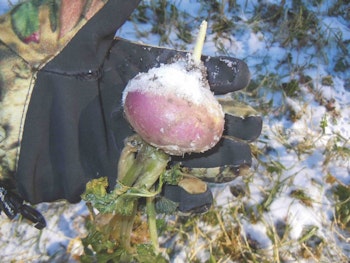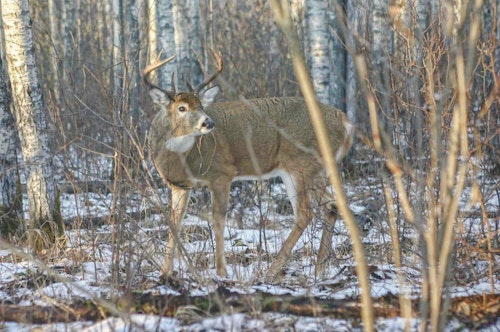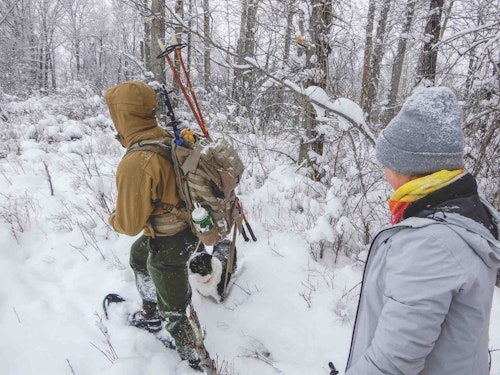Few of us embrace the full effect of winter on our life. Sure the skiing, ice skating and sledding offer a great escape, but daily shoveling, driveway clearing and frozen pipes abruptly bring icy reality back to your life. Whitetails may not have to deal with frozen pipes, but basic survival comes into play during a day-to-day existence, especially for whitetails living closer to Canada than the Gulf of Mexico. Don’t forget about the whitetails on the property you manage when you curl up with a good book by the fire. Have a plan in place to guarantee your winter wonderland doesn’t become a whitetail wasteland.
I’ll Take a Salad, Please
Whitetail property managers are food plot crazy. They farm like an over-caffeinated cultivator, but for some it is only to succeed during hunting season. That’s admirable, but you need to think year-round for food plots and inventory the rest of your property to determine if food plots can’t deliver, will Mother Nature be able to stock the shelves until spring? If the answer is no, then you likely need to diversify your food plots. Diverse plots feed the hungry throughout the year, especially in crucial winter months. By diversifying your food plots, whitetails will tend to graze certain species of plants during certain times of the year, allowing some species to make it until winter.
Crops like sugar beets, winter wheat and brassicas are excellent winter food sources. Furthermore, the entire family of leafy brassicas should be considered including turnips, rape, kale and canola. After several frosts most of these species become more palatable to whitetails. In addition, as winter wanes, crops like winter wheat provide a quick spring green-up, which provides a critical jumpstart.

Corn and soybeans are also excellent food sources. Soybeans shine in high protein, and corn is a natural body heater that deer crave when temperatures plummet. Unfortunately, these two caviar food sources can be difficult to keep on the shelf as deer find them irresistible.
Variety is key, and beyond your food plots a property should also offer a good selection of browse. On average, whitetails browse on as many as 20 different plant species a day, sometimes more and sometimes less depending on availability. Some browse is available only seasonally while others occur only in specific regions of whitetail country. Visiting with a certified forester could reveal ways to open canopies and hinge-cut trees to increase natural browse opportunities.
While closing the pantry door to this section you may also consider supplemental feeding. Baiting is legal in many states, and stationing corn or alfalfa bales around your property can surely carry deer over the winter if they have time to adjust to the diet change. Regrettably, feeding deer becomes costly, particularly if you are subject to high deer density. That’s why food plots, forestry and sound property management need to work in concert to ease winter whitetail woes.
Give Me Shelter
As you inventory food and set the table, take a long, hard look at the available shelter on your property, especially stormproof habitat near food. Whitetails may not use these areas daily, but when the barometer drops, winds kick in and a Siberian Express rolls across the landscape, deer move to these protected living quarters.
Shelter could show up in the form of cedar swamps, farmland woodlots, cattail wetlands, briar thickets and even deep coulees. It should be close to food, a mile or less, and it should offer protection from brutal winds above all else. Deer maintain warmth by getting out of winds, particularly subzero gusts. Whitetails have the ability to live through a long winter due to their natural resilience, but when shielded by geography or vegetation they can cruise through most winter weather events as long as the food bank is open.

Winter protection may not always look like the textbook pictures of a deep, oak draw. I’ve seen property managers push fallen timber together to create giant walls for whitetails to bed behind. Growing up in South Dakota, I was witness to many properties that looked as bleak as the Mojave Desert. I saw deer using the rolling hills as weather barriers. Narrow, human-planted windbreaks also concentrated deer when a blizzard pummeled my home area.
If you don’t have either of those features present, you can always plant crops to block the wind and provide a defensive wall against the elements. Tall, hardy crops like sorghum, Egyptian wheat (also a member of the sorghum family) and even ornamental reed grass used for landscaping can break the wind. Corn will serve as a windbreak in larger plantings as can shorter crops such as milo. Both serve as nutrition in addition to their wind-blocking nature.
One of my favorite sights is a standing cornfield in the middle of winter. Deer flock to it from miles away for shelter and food. Unfortunately, the lackadaisical farmer will rarely have much to harvest when the snow melts.
Leave Me Alone
Lastly, if the table’s set in an igloo-like setting, you need to leave the diners alone. Trending today in whitetail management is setting a portion of a property off limits to any activity, including hunting. That’s great in the months running up to the season and during your hunt, but don’t break the off-limits barrier after the whitetail season closes.
Whitetails, when it comes to survival, have a serious hunker mode. In some extreme northern areas, whitetails may bed up to 70 percent of more of the day. Think of it as artificial hibernation. By not moving, deer conserve energy by not burning fat. Anytime a whitetail, particularly a buck, is up and moving, it burns calories that it cannot replace. In many winter locales, food intake can decrease by as much as 25 percent. All of these factors scream “leave me alone.” Every time you bump deer, it jeopardizes their survival as they flee, sometimes through belly-deep snow. Stress could eventually kill the deer and some may simply pack their bags and move to the neighbor’s land.
These off-limit areas should be large enough to provide enough isolation that whitetails don’t feel human pressure. Although this category could be tied to shelter, sometimes the two don’t always mix. Think of areas that are removed from roads, building sites and don’t have attractions where you might be tempted to visit. Even so, they should have the shelter comfort of wind protection to certainly double as a no-trespassing deer retreat.
Some states have hunting seasons after the Christmas lights come down. These can be ideal opportunities to enjoy winter, trim doe numbers and even introduce young hunters to the sport. Nevertheless, the temptation to hunt deer patterns close to food or shelter could stress deer.

In addition to hunting activity, limit all human activity including wood cutting, hiking and the ever-addictive activity of shed antler hunting. If you maintain a trapping program for predator control, work the perimeters instead of barging into the interior haven. For the public land hunter, you need to simply follow ethical behavior. Stay away from habitat deer use as winter escape and suggest to others that they do the same.
You may not be able to bring the Bahamas to deer on your hunting property, but with a bit of help you can make the sting of winter a bit less biting.






